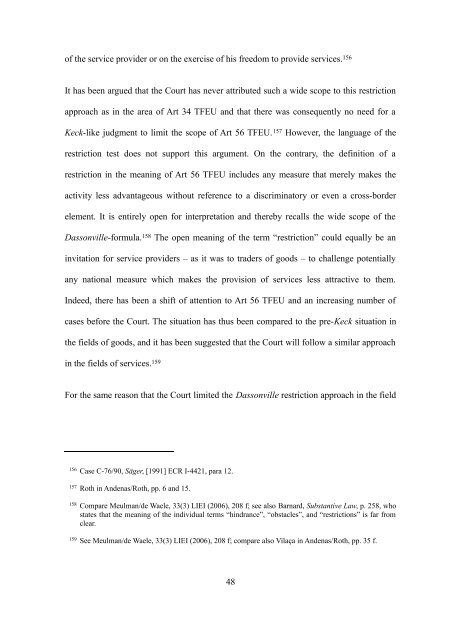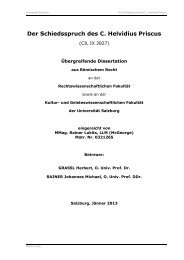(post) Keck Case Law on the Freedom to Provide Services
(post) Keck Case Law on the Freedom to Provide Services
(post) Keck Case Law on the Freedom to Provide Services
You also want an ePaper? Increase the reach of your titles
YUMPU automatically turns print PDFs into web optimized ePapers that Google loves.
of <strong>the</strong> service provider or <strong>on</strong> <strong>the</strong> exercise of his freedom <strong>to</strong> provide services. 156It has been argued that <strong>the</strong> Court has never attributed such a wide scope <strong>to</strong> this restricti<strong>on</strong>approach as in <strong>the</strong> area of Art 34 TFEU and that <strong>the</strong>re was c<strong>on</strong>sequently no need for a<str<strong>on</strong>g>Keck</str<strong>on</strong>g>-like judgment <strong>to</strong> limit <strong>the</strong> scope of Art 56 TFEU. 157 However, <strong>the</strong> language of <strong>the</strong>restricti<strong>on</strong> test does not support this argument. On <strong>the</strong> c<strong>on</strong>trary, <strong>the</strong> definiti<strong>on</strong> of arestricti<strong>on</strong> in <strong>the</strong> meaning of Art 56 TFEU includes any measure that merely makes <strong>the</strong>activity less advantageous without reference <strong>to</strong> a discrimina<strong>to</strong>ry or even a cross-borderelement. It is entirely open for interpretati<strong>on</strong> and <strong>the</strong>reby recalls <strong>the</strong> wide scope of <strong>the</strong>Dass<strong>on</strong>ville-formula. 158 The open meaning of <strong>the</strong> term “restricti<strong>on</strong>” could equally be aninvitati<strong>on</strong> for service providers – as it was <strong>to</strong> traders of goods – <strong>to</strong> challenge potentiallyany nati<strong>on</strong>al measure which makes <strong>the</strong> provisi<strong>on</strong> of services less attractive <strong>to</strong> <strong>the</strong>m.Indeed, <strong>the</strong>re has been a shift of attenti<strong>on</strong> <strong>to</strong> Art 56 TFEU and an increasing number ofcases before <strong>the</strong> Court. The situati<strong>on</strong> has thus been compared <strong>to</strong> <strong>the</strong> pre-<str<strong>on</strong>g>Keck</str<strong>on</strong>g> situati<strong>on</strong> in<strong>the</strong> fields of goods, and it has been suggested that <strong>the</strong> Court will follow a similar approachin <strong>the</strong> fields of services. 159For <strong>the</strong> same reas<strong>on</strong> that <strong>the</strong> Court limited <strong>the</strong> Dass<strong>on</strong>ville restricti<strong>on</strong> approach in <strong>the</strong> field156<str<strong>on</strong>g>Case</str<strong>on</strong>g> C-76/90, Säger, [1991] ECR I-4421, para 12.157Roth in Andenas/Roth, pp. 6 and 15.158Compare Meulman/de Waele, 33(3) LIEI (2006), 208 f; see also Barnard, Substantive <str<strong>on</strong>g>Law</str<strong>on</strong>g>, p. 258, whostates that <strong>the</strong> meaning of <strong>the</strong> individual terms “hindrance”, “obstacles”, and “restricti<strong>on</strong>s” is far fromclear.159See Meulman/de Waele, 33(3) LIEI (2006), 208 f; compare also Vilaça in Andenas/Roth, pp. 35 f.48




